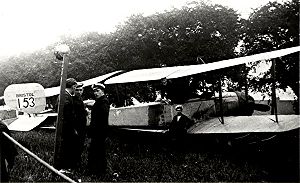Bristol TB.8 Video - Picture

|
|
Bristol TB.8
T.B.8

Role: Trainer
Manufacturer: Bristol Aeroplane Company
Designed by: Henri Coandă
First flight: 1913
Introduced: 1913
Retired: 1916
Primary users: Royal Naval Air Service
Royal Flying Corps
Romanian Air Force
Number built: 54
Developed from: Bristol-Coanda Monoplanes
The Bristol T.B.8 was an early (1913-14) British biplane built by the Bristol Aeroplane Company, which was produced in significant numbers (54 were built) for the time. While mainly used as a trainer, T.B.8s were briefly used as bombers at the start of the First World War by the Royal Naval Air Service (RNAS).
Design and development
Henri Coandă, chief designer of the Bristol Aeroplane Company, developed the T.B.8 as a biplane development of his earlier Bristol-Coanda Monoplane to meet an order from the British Admiralty, the first aircraft, a conversion of a Bristol-Coanda monoplane, flying on 12 August 1913 . This aircraft was tested with both wheeled undercarriage and floats.
The T.B.8 was a single engined, two seat biplane, with two bay wings and a slender fuselage. While early T.B.8s used wing warping, later production aircraft were fitted with ailerons. They were normally fitted with a distinctive four wheel undercarriage. T.B.8s were powered by a variety of rotary engines, including Gnome and Le Rhx´ne engines with power ranging from 50 hp Gnomes to 100 hp Gnome Monosoupape engines . T.B.8s were produced both by conversion of Coanda Monoplanes, and by new production.
One T.B.8 was fitted with a prismatic Bombsight in the front cockpit and a cylindrical bomb carrier in the lower forward fuselage capable of carrying twelve 10 lb (4.5 kg) bombs, which could be dropped singly or as a salvo as required . This aircraft was displayed at the Paris Salon de l'Aéronautique and evaluated by the French military before being purchased by the RNAS.
Operational history
T.B.8s were purchased for use both by the Royal Naval Air Service and the Royal Flying Corps (RFC), with the RFC's T.B.8s being transferred to the RNAS shortly after the start of the First World War . Three T.B.8s, including the aircraft displayed at Paris in December 1913, and fitted with bombing equipment, were sent to France following the outbreak of war, serving with the RNAS squadron commanded by Charles Rumney Samson. One of these T.B.8s carried out a bombing attack on German gun batteries at Middelkerke, Belgium on 25 November 1914, the only bombing sortie flown by the T.B.8 . The T.B.8 was considered too slow for front line operations, and was relegated to training operations, serving until 1916 .
The T.B.8 was also used by Romania, with six Bristol-Coanda Monoplanes operated by the Romanian Military Aviation school being converted by Bristol into T.B.8s.
Variants
The Romanian government were pleased with their T.B.8s and placed an order for an improved version, for which they provided a 75 hp (56 kW) Gnome Monosoupape engine. The resulting aircraft, designated the G.B.75 was significantly different in appearance, with a streamlined front fuselage and rounded cowling enclosing the rotary engine. The characteristic Coanda fin was replaced with an unbalanced rudder plus fin. Maximum speed was up a little to 80 mph (130 km/h). It first flew on 7 April 1914 and required the removal of the spinner and an increase in stagger to adjust the centre of pressure, but was judged ready for delivery in June. It did not go to Romania, however and instead served the RFC at Farnborough, powered by a standard Gnome engine.
Operators
Romania
Romanian Air Force operated 6 aircraft.
United Kingdom
Royal Flying Corps
Royal Naval Air Service
Specifications (T.B.8)
Data from Bristol Aircraft Since 1910
General characteristics
Crew: Two
Length: 29 ft 3 in (8.92 m)
Wingspan: 37 ft 8 in (11.48 m)
Height: ()
Wing area: 450 ft² (41.8 m²)
Empty weight: 970lb (441 kg)
Max takeoff weight: 1,665 lb (757 kg)
Powerplant: 1x— Gnome Rotary engine, 80hp (60 kW)
Performance
Maximum speed: 56 - 61 knots (65-70 mph, 105 - 113 km/h)
Endurance: 5 hours
Climb to 3000 ft (915 m): 11 min
Armament
Light bombs
Bristol TB.8 Pictures
Living Warbirds: The best warbirds DVD series.
Source: WikiPedia